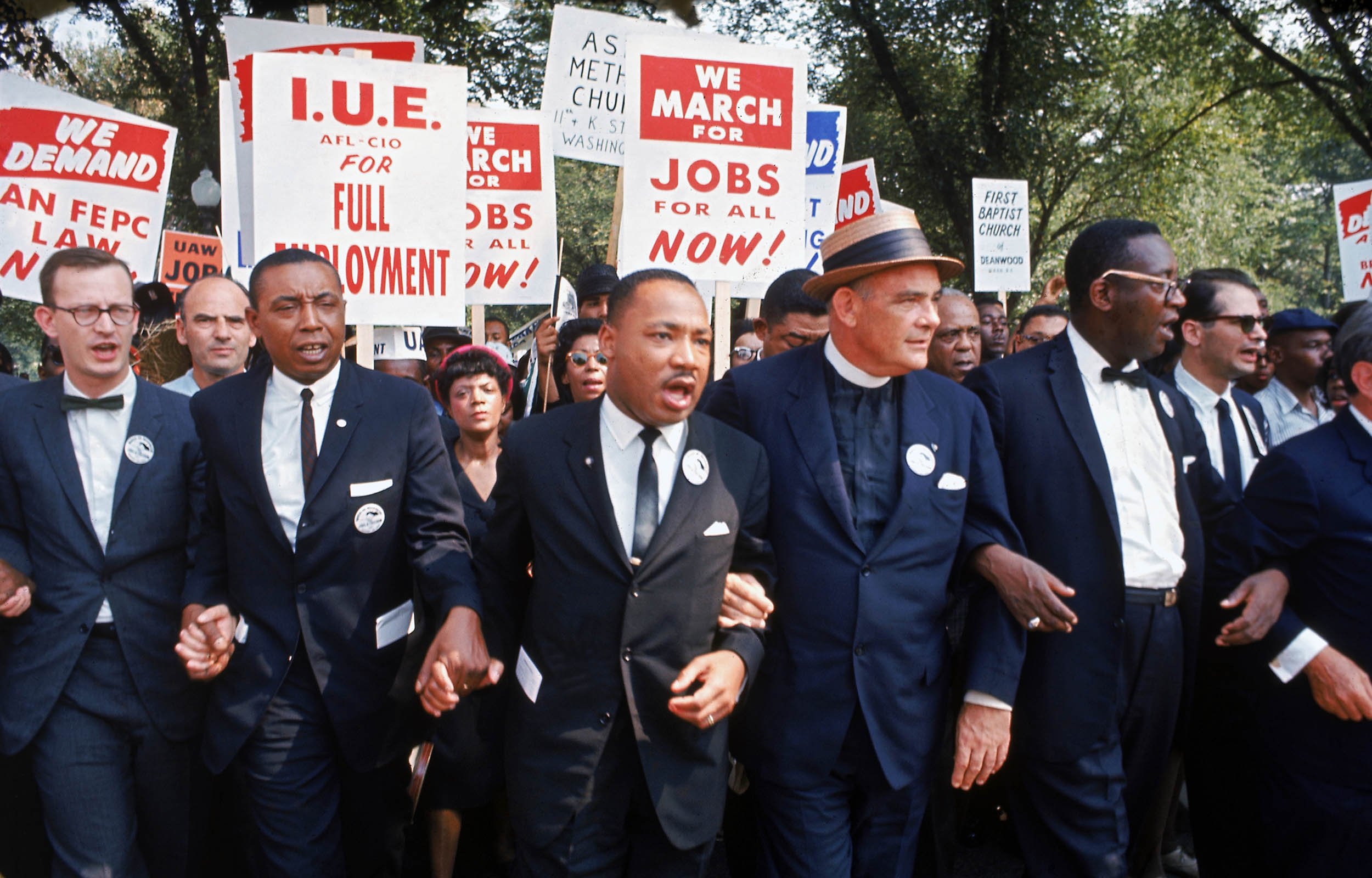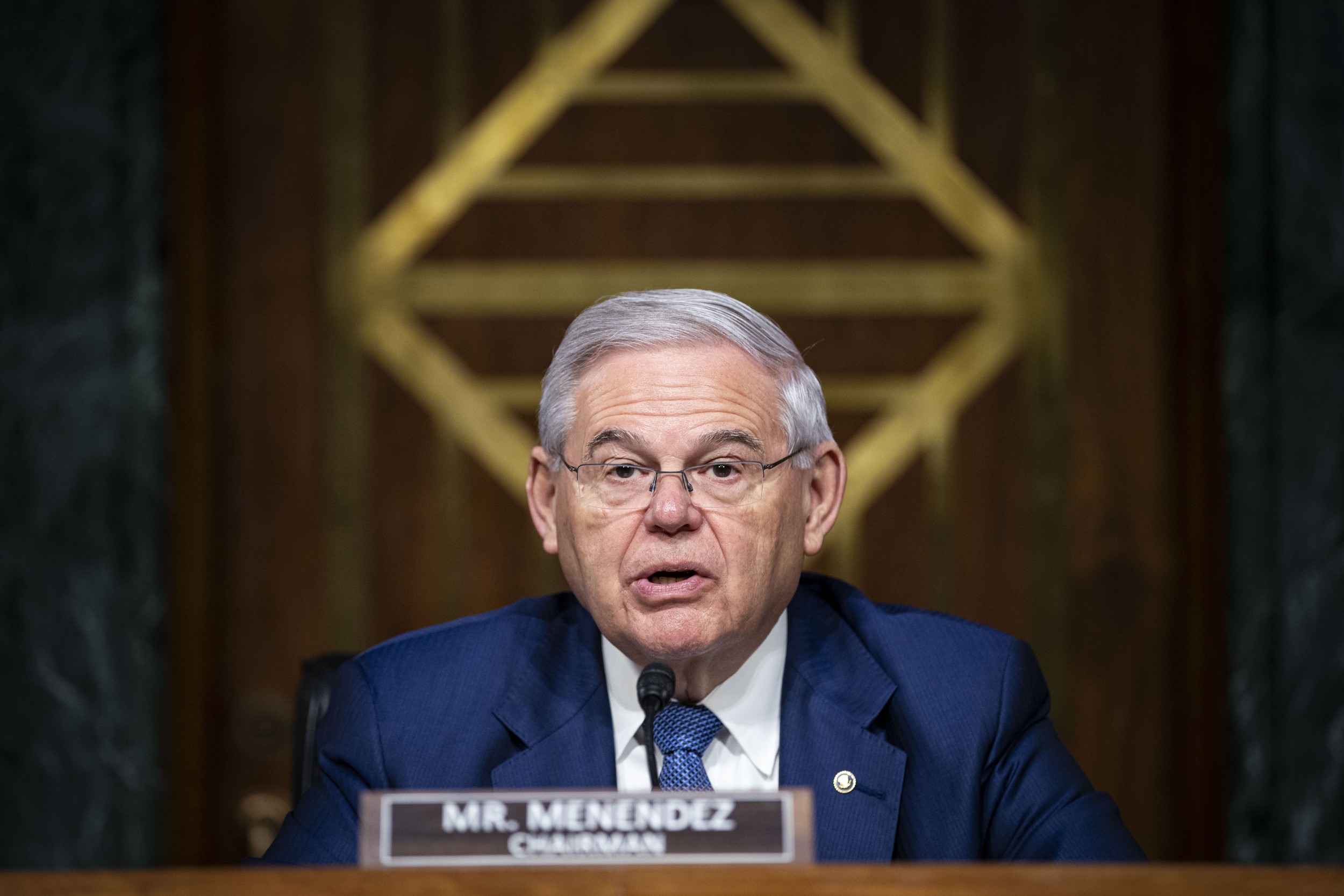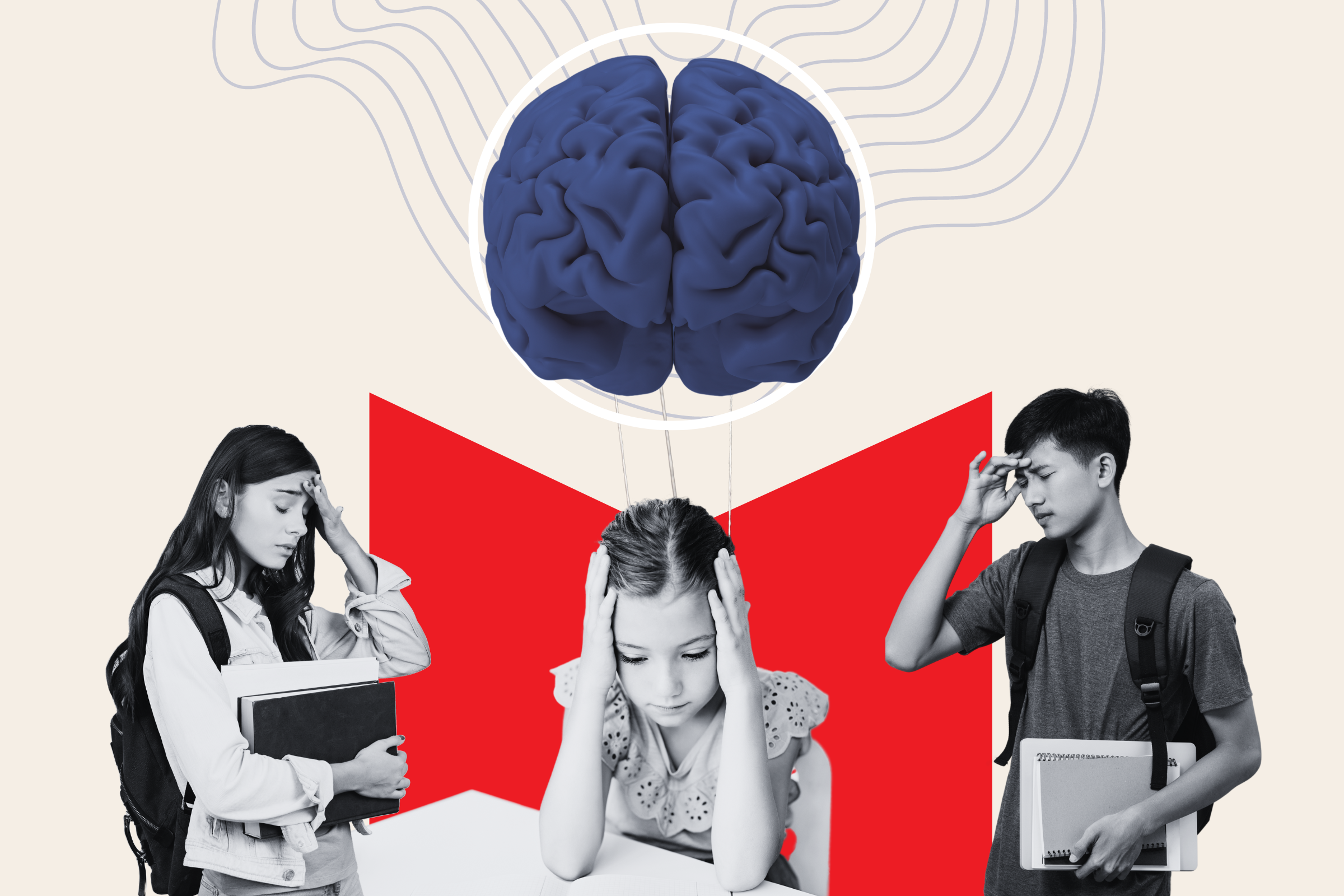
Before thousands of Americans descended on Washington, D.C., to march for equality and before Martin Luther King Jr. delivered a speech that earned him a chapter in history, the organizers of the August 28, 1963 March on Washington had to plan. How were they going to transport, feed, care for and keep calm the roughly 100,000 people expected for the march? How many white people should participate compared to black people? In its September 2, 1963 issue, Newsweek provided a behind-the-scenes look at the politics and planning that went into a march that swept Martin Luther King Jr. and the civil-rights movement into the national spotlight.
From across the nation they were coming, black and white, in twos and threes and scores and hundreds, in cars and buses and trains and chartered jets.
They were coming by bus from Los Angeles and San Francisco, a round trip of seven steamy days and six insomniac nights. They were coming from Cleveland, Mississippi, where some 40 jobless Negroes were raising the $33 bus fare by selling symbolic shares in their tickets at $1 apiece. They were coming by chartered airlines from Cleveland, Ohio -- among them an 81-year-old woman taking her first plane ride. They were coming from New York City, perhaps 40,000 strong in 600 chartered buses and 10 special trains. They were coming from the show-biz colonies of Broadway and Hollywood, with Charleton Heston -- unaccustomed though he was to a supporting part in a cast of thousands -- leading a phalanx of movie stars. If they couldn't come any other way, a young Negro leader said, "they'll look down and say, 'Feet, start movin'." Indeed, a dozen were walking 237 miles down from Brooklyn, and Ledger Smith started on the 689-mile road from Chicago Aug. 17 on roller skates. (*He passed Uniontown, Pennsylvania by the weekend and kept rolling.)
They were coming to an officially confident but privately uneasy Washington for the biggest single march on the capital in U.S. history -- bigger by far than Jacob Coxey's ragtag army of 1894 and the suffragette legions of 1913 and the bonus march of 1932 all rolled into one. Their banners claimed it a march for "jobs and freedom." Their bill of particulars called for quick and wide-ranging action on the nation's No. 1 domestic problem: the revolt of the American Negro.
Plans called for the marchers -- 100,000 to 200,000 of them -- to rendez-vous starting before dawn around the Washington Monument, a towering, 550-foot pencil of white against the sky. At 11:30, the throng would march at last, the leaders on the Constitution Avenue, the marchers down Independence Avenue and on either side of the Reflecting Pool, placards bobbing like sails on a river, voices joined in the slow cadence of an old Baptist hymn made over into a song of revolution:
We shall overcome,
We shall overcome,
We shall overcome som da-a-ay …
A mile from the starting point was the goal: the gleaming white marble Lincoln Memorial. There, with the larger-than-life statue of the president who tendered freedom to 3.5 million slaves gazing out through the colonnade, the leaders would demand once again that his century-old promise be fulfilled. Afterward, a delegation would present that demand to the president and the leaders of the 88th Congress.
And then, according to the plan, they would drift away, back to the cars, buses, trains and planes heading home.
In plain pragmatic terms, the march -- as a lobbying effort -- was hardly likely to work miracles on Capitol Hill. Congress was headed for a long, tough fight over the president's own civil rights bill, let alone the demands of the marchers: an even stiffer rights measure, immediate school desegregation, an FEPC law, massive full-employment measures.
The Kennedys, unsettled at the first announcement of the march, came to accept it as an inevitable -- and possibly useful -- fact of life. After twice giving the march his publish blessings, in fact, the president could only hope that it would be a success, in numbers and in discipline. Yet White House expectations were not high. "If there is an incident, it will not hurt," one staffer said. "If not, it may have a faint positive aspect."
But, for its leaders, the march developed its own mystique. They no longer regarded it simply as a lobbying display or an isolated on-day event. It became, for them, a culmination of the summer of revolt, a solemn, massive sacrament in which thousands of Negroes and their white friends in churches, unions and liberal circles could share the revolutionary passion born last spring in Birmingham. "The presence of hundreds of bodies presenting living witness to the truth," said Martin Luther King Jr., "will help Congress see the determination of the Negro."
'Sacred': And when courtly, 74-year-old A. Philip Randolph -- the man who first suggested the march -- talks about his dream come true, his cool eyes burn and his hands fly as though choreographing the demonstration in his mind. "This [march] is a sacred cause," says Randolph, president of the Brotherhood of Sleeping Car Porters and acknowledged elder statesman of The Movement. "This is a full-dress revolution, an inevtiable outgrowth of the incompleteness of American history. A great demonstration like this will help channel the Negro's sense of desperation into a creative enterprise…. We can't blast out prejudice by holding erudite conferences. Talk isn't powerful enough to change the social fiber."
Randolph's idea, at first, was a march of jobless Negroes in October to demand action on what he regards as the top-priority problem: an unemployment rate twice as high as the white man's. By threatening such a march in 1941, he forced FDR to issue an executive order against employment discrimination in defense plants. He organized King's 1957 prayer pilgrimmage to Washington and a pair of youth marches on the capital in 1958 and 1959. "Mr. Randolph is a march man," says National Urban League executive director Whitney Young. "He's been marching since 1941."
Last winter, Randolph decided it was time to march again. He did what he had done when he needed a youth director in '41 and a chief of staff in the '50s: He called in Bayard Rustin.
Since they first met, Rustin -- an angular, intense, chain-smoking intellectual of 53 -- had quietly become one of the most influential figures in the welling Negro revolt. Yet, because he is not a professional leader at all, he is barely known outside The Movement. His first cause, as a Quaker and a pacifist, is nonviolence; his job is executive secretary of the War Resisters League. His beliefs have often drawn him into the civil rights cause, as a 22-arrest veteran of the first freedom rides in 1947, a founder of the Congress of Racial Equality, an architect of King's Southern Christian Leadership Conference. They have taken him around the world as well, as a student of the Gandhi movement in India, a comrade of Ghana's Kwame Nkrumah, Kenya's Tom Mboya and India's Jawaharlal Nehru, organizer of the first Aldermaston peace walk in England, an anti-bomb march in France and a rally against renascent anti-Semitism in West Germany. "He has a way of popping out of the shadows when he's needed," one friend says. "He is responsible for the thinking behind the Negro revolution today, yet he isn't even considered a Negro leader -- nor does he want to be."

Judgment: The opposition pointed out some embarrassing items, too: a stretch in the Young Communist League in the late 1930s, a 29-month sentence for refusing to register for the draft during World War II, a morals conviction in 1953. Said Rustin: "It is for my peers to judge me and my life."
His peers in the civil rights march leadership judged that he was indispensable. Author of the original working plan for the march, he serves as Randolph's 15-hour-a-day deputy director. "Rustin's not a conformist," one leader said. "He looks like he needs a haircut and a clean shirt. But he's a genius at organization."
Randolph was already sending up trial balloons when he got Rustin's woking memo last winter. But only the charge of electricity generated by the Battle of Birmingham set the march moving full speed. Martin Luther King Jr. joined up -- and helped persuade Randolph to broaden the target from unemployment to the whole range of civil rights issues. The other activist leaders followed -- CORE director James Farmer and Student Nonviolent Coordinating Committee chairman John Lewis.
Big Six: For a time, the heads of the two oldest and biggest of the Big Six Negro leadership groups -- the Urban League's Young and the NAACP's Roy Wilkins -- remained outside. But Wilkins found the NAACP convention last June in a marching mood. And both men were disturbed by talk that the march might be a Negro-only affair, that marchers would break an 1882 law against demonstrating on Capitol Hill, that -- as one King subaltern announced -- Negroes would stage "massive acts of civil disobedience" across the U.S. One insider recalled: "Roy and Whitney said they'd join on two conditions: that it have a broader base -- whites, churches, labor as well as Negroes -- and absolutely no civil disobedience.
The two won their way on both key points. The Big Six started meeting weekly in the League's midtown Manhattan board room -- a symbolic recognition itself of the soft-spoken, tough-minded Young's role as mediator among the often competitive civil rights groups. King said his man had spoken out of turn on civil disobedience; it wouldn't happen again. And the leaders ruled out sending marchers to the Hill at all. Instead, they would invite all members of Congress to come to the march -- and duly note the absentees.
The Negro-white ratio proved a stickier question. A bloc led by Randolph, one insider said, thought Negroes should heavily outnumber whites; administrative committee chairman Cleveland Robinson, a Randolph aide, suggested a 75-25 breakdown. Rustin, from his first memo on, took a 50-50 middle view. "If white people didn't come, it would be a struggle of black against white, not justice against injustice." A third bloc was bluntly pragmatic. "It doesn't make me any difference if it's 90 percent white," one said. "I think that's better if we're trying to influence legislation. We've already made the point that we're concerned through this whole year's activity."
Line-up: As white Americans lined up for places, they were simply incorporated in the plans -- and in Randolph's master vision as well. "The march must be integrated," he said. "The idea of Negroes and whites locked in mortal warfare -- that's just not true."
Eventually, the Big Six grew to a mixed 10 with the addition of United Auto Workers president Walter Reuther and representatives of the three major faiths. To Reuther's chagrin, the AFL-CIO executive council refused to endorse the march and cranked out a civil rights statement he diagnosed as "so anemic it needs a blood transfusion to keep it alive on the way to the mimeograph machine." But unions put up money -- nearly half the $110,000 national budget -- and marchers.

Joiners: Other groups joined. The fledgling Commission on Religion and Race of the National Council of Churches called a Washington assembly as part of the march and estimated 40,000 would come. New York City's Catholic vicar general, the Most. Rev. John J. Maguire, urged support in a letter read at masses in all 402 parties. Other religious leaders -- Catholic, Jewish, Protestant -- joined in. Several mayors offered city employes a day's leave to march. One of them, New York's Robert Wagner, promptly took up his own offer -- though, next day, he ordered the eviction of a boisterous convey of rights demonstrators after a 44-day sit-in at his own City Hall office. For those who couldn't come, there were sympathy marches on statehouses at home and U.S. embassies abroad. In Paris, the much-lionized James Baldwin -- in temporary retreat from the race struggle while he finished a play -- joined the walk from the American Church on the Quai d'Orsay to the Embassy.
As the march grew, so did the mass of logistical detail -- the problems of moving, feeding and controlling an army of demonstrators.
Rustin set up headquarters in the sooty, yellow stucco Utopia Neighborhood Club House in Harlem. His day ran from 10 one morning to 1 the next -- days spent puffing cigarettes, doing mental arithmetic ("If we needed X number of toilets for 30,000 in 1959, we'll need …"), opening mail and dickering with printers and lugging folding chairs and always talking -- to visitors, phone callers, staffers: "We planned around the figure of 100,000 but a good planner always plans for 150,000 … Mr. Randolph, that would be a tragic mistake, the President is pulling a fast one, make no move till we have a chance to talk … Good I caught you, make those cards 2 ½ by 3 ½ so they can make pins out of them."
The plans emerged.
Transportation? Local committees procured some planes for long hauls, but most were coming by car, or on 2,200 chartered buses and 40 special trains. Most paid their own way, though national headquarters budgeted some funds to bring the needy jobless -- the foot soliders of Randolph's dream army. In Washington itself, hundreds of police were on hand to steer traffic, and street parking was banned in a vast corner of Northwest Washington to make room for buses. With Union Station's traffic load swollen to a train every 10 minutes from 6 a.m. to noon, D.C. Transit Company set up a shuttle-bus run to and from the monument grounds.
Bag Lunches: March manuals suggested bringing two box lunches per person (no perishables like mayonnaise, salads, rich foods) and Thermos jobs of water (no alcohol allowed). Even so, the Church World Service in New York set up a three-shift crew of 300 volunteers to pack 80,000 bag lunches (a cheese sandwich, an apple, a slice of pound cake), for sale at 50 cents each. And the District was bringing in eight 2,500-gallon tank trucks, five 250-gallon water trailers, and four-place fire hydrant bubblers -- enough, said deputy public health director Frederick C. Heath, to give "35,000 people an hour a good, long drink of water."
There would be 26 comfort stations, some of them giant government trucks with facilities for 30 or 40 people, and 22 first-aid stations -- each with two doctors, four nurses, two ambulances, and supplies enough to deal with anything from broken limbs and heart attacks to sunstroke and blistered feet. Marchers were under instruction to leave town Wednesday night, but a housing committee tried to line up 1,000 emergency beds. One woman, according to a story making the rounds, offered 20 -- but for white marchers only, please.
And trouble? Of there were sparks, the plan was to snuff them out, quickly and decisively. The 180-acre demonstration site and a wide area around it would be blanketed with men: 2,000 police, 2,000 National Guardsmen, 200 park police. Nearby, 4,000 Army and Marine troops were on call. And the march leaders were fielding 2,000 marshals, under orders to isolate any troublemakers swiftly and quietly, persuade them to behave if possible, call police by walkie-talkie if necessary.
Certainly the ingredients of trouble were there -- tens of thousands of marchers massed in the area; the presence of provocateurs like American Nazi George Lincoln Rockwell, who promised to show up, and the fact that Washington remains a city with a Southern exposure. Then, too, among the marchers would be many activists accustomed to livelier forms of protest than a ritual walk and a round of talk. Actually, the whole tone of the march had changed since the days when talk of sit-ins and lie-ins and chain-ins set the Hill on edge. "This demonstration," a District official said, "has become too respectable and popular and stuffy to spark an explosion."
It was far more than that, of course, to the Negro leaders and to the marchers themselves. Few would argue with President Kennedy's press conference remark that the issue of civil rights "does not stand or fall on the [events of] August 28." Yet, by walking a single symbolic mile in the nation's capital, by exercising in unprecedented numbers the right of all Americans "peaceably to assemble and to petition the government for a redress of grievances," they hoped to underscore something else the president had suggested. The Negro's struggle for equality was not a job for the Executive alone, for Congress alone, for the Negro alone. "What we're really talking about," the president said last week, "is a problem which involves 180 million people."
Uncommon Knowledge
Newsweek is committed to challenging conventional wisdom and finding connections in the search for common ground.
Newsweek is committed to challenging conventional wisdom and finding connections in the search for common ground.
About the writer
To read how Newsweek uses AI as a newsroom tool, Click here.





